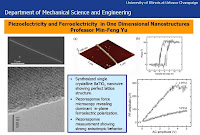Super small nanoelectrodes can probe microscale environments (Click Image to Play VIDEO)
 | CHAMPAIGN, Ill. -- Investigating the composition and behavior of microscale environments, including those within living cells, could become easier and more precise with nanoelectrodes being developed at the University of Illinois., High Resolution Image |
To fabricate the nanoelectrodes, Yu and graduate students Kyungsuk Yum, Jie Hu and Han Na Cho begin by attaching a strong, rigid, boron-nitride nanotube to a much larger, conductive probe. The nanotube will form the insulating core of the nanoelectrode.
The researchers then coat the nanotube with a thin film of gold about 10-50 nanometers thick (a nanometer is 1 billionth of a meter.) The gold layer is then coated with an insulating polymer coating about 10 nanometers thick. Lastly, the researchers use a focused ion beam to slice off the end of the nanotube, exposing a conducting ring of gold sandwiched between an insulating core and an insulating outer ring.
The process yields nanoelectrodes with a diameter of 100 nanometers, and a length of up to 30 microns.
Because the nanotube is attached to a much larger probe, the researchers can manipulate the nanotube like a needle. They can control precisely where the nanotube penetrates a cell, for example, and even pinpoint smaller cell structures, such as the nucleus or mitochondrion.
"Nanoelectrodes offer new opportunities for electrochemical sensing in intracellular environments," said Yu, who will describe the fabrication process and demonstrate the feasibility of nanoelectrodes at the March meeting of the American Physical Society, to be held in Denver, March 5-9. "By functionalizing the active area of the nanoelectrode with an appropriate chemical, we can target the detection of specific chemical species."
The researchers have demonstrated that their nanoelectrode can sense the chemical environment within a droplet 10 microns in diameter. Their next step is to show that the probe can penetrate the cellular membrane of a living cell, without damaging the cell. ###
 | High Resolution Image, The National Science Foundation and the University of Illinois funded the work. (Click Image to Play VIDEO) |
Technorati Tags: nanofibers or Nanoscientists and Nano or Nanotechnology and nanoparticles or Nanotech and nanotubes or nanochemistry and nanoscale or nanowires and Nanocantilevers or nanometrology and microscale environments or nanoelectrodes and University of Illinois at Urbana-Champaign or mitochondrion














No comments:
Post a Comment